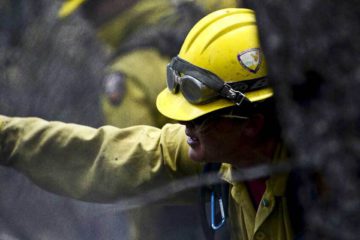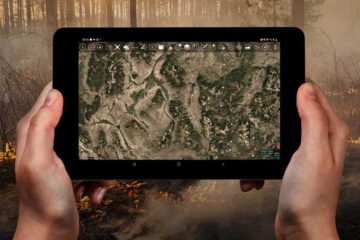8 grant programs for acquiring interoperable, resilient mission-critical comms solutions

State and local government agencies are increasingly depending on mobile devices, including smartphones, for communication and data sharing during emergency and disaster response situations. However, for many of these organizations—such as law enforcement, emergency responders, and other first responders—the cellular networks they rely on can become unavailable when needed most.
In October of this year, Verizon Wireless experienced a significant outage that left tens of thousands of customers unable to make outbound calls or receive inbound calls. Others could not use their devices, with phones entering “SOS mode.” This outage was not an isolated incident. Another outage in February of 2024 left tens of thousands of AT&T customers without service and impacted numerous state and local government systems. According to CNN, this outage impacted 911 service for multiple emergency management departments and even left the New York Police Department unable to make calls or utilize emails.
These outages resulted from technical difficulties, which could happen at any time. However, technical difficulties are only one reason why terrestrial networks fail. Terrestrial networks are often a casualty of natural disasters and emergencies. Hurricanes, wildfires, floods, terror attacks, and other emergency scenarios can physically impact network infrastructure, degrading networks and causing outages.
There is also the impact of special events and emergency situations, which can overload networks. Large sporting events, concerts, and other cultural events can bring large crowds of people into a small area. This can easily overload cellular networks. Emergency scenarios can have a similar effect, as friends, family, and loved ones all try to reach out to those in the area to ensure that they’re alive and well – overloading networks and making communication impossible.
The fragility of these communication networks is a problem for national security and public safety. The loss of communication can severely impact emergency response operations and overall resilience.
New, resilient communications solutions, such as mobile mesh networking devices, can be a solution for state and local governments looking for assured networks for their law enforcement and emergency response operations. These devices enable the rapid deployment of an ad-hoc mesh network that can allow mission-critical communications and situational awareness capabilities – including sending messages and sharing geographic locations – without traditional cellular, Wi-Fi, or satellite networks.

State and local government agencies often face tight budget constraints, making investing in new technologies—even affordable options like mobile mesh networking radios challenging. Fortunately, various new and established grant programs are available to help these agencies secure funding for acquiring and implementing mobile mesh networking solutions.
1. Operation Stonegarden Program (OPSG)
- Total funding available in FY 2024: $81 million
- Eligibility: State Administrative Agencies and local units of government at the county level or equivalent level of government and federally recognized tribal governments in states bordering Canada or Mexico and states and territories with international water borders. All applicants must have active ongoing USBP operations coordinated through a CBP sector office to be eligible for OPSG funding.
OPSG grants are focused on enhancing cooperation and coordination among U.S. Customs and Border Protection and other federal, state, local, tribal, and territorial law enforcement agencies to improve overall border security at both the northern and southern land borders, as well as in states and territories with international water borders.
Given the frequent communications challenges in austere and remote border regions, this grant could support programs and equipment designed to enhance agencies’ joint technical and operational readiness, especially as National Guard units are being deployed to the U.S. southern border, U.S. northern border, and other hotspots. Like SHSP and UASI, state and local organizations in priority border areas must request funding through their SAA.
2. U.S. Department of Justice Technology and Equipment Program
- Total funding available in FY 2024: $247.3 million
- Eligibility: State, local, tribal, territorial, and other entities that need funds to acquire equipment, technology, and interoperable communications.
The Technology and Equipment Program is managed by the U.S. Department of Justice, Office of Community Oriented Policing Services (COPS Office), which awards grants to state, local, tribal, territorial, and other entities to acquire equipment, technology, and interoperable communications. This funding promotes community policing and crime reduction.
3. Edward Byrne Memorial Justice Assistance Grant (JAG) Program
- Total funding available in FY 2024: $180.5 million
- Eligibility: States, territories, tribes, and local governments that need funding to support law enforcement programs.
The Edward Byrne Memorial Justice Assistance Grant (JAG) Program is provided by the Office of Justice Programs (OJP). It offers law enforcement equipment purchase grants, including most special operations gear and technology improvement. The National Tactical Officers Association (NTOA) is another OJP program. It awards funds for vehicles and equipment for SWAT teams that are members of the NTOA.
4. Community Facilities Direct Loan and Grant Program
- Total funding available in FY 2024: $38 million
- Eligibility: Public bodies, community-based non-profit corporations, and federally-recognized tribes in rural areas, including cities, villages, townships, and towns including Federally Recognized Tribal Lands with no more than 20,000 residents according to the latest U.S. Census Data.
The Community Facilities Direct Loan and Grant Program is provided by the U.S. Department of Agriculture (USDA) to support public safety services such as police stations, vehicles, and public works vehicles or getting equipment in communities with populations of 20,000 or less.
5. Emergency Management Performance Grant (EMPG)
- Total funding available in FY 2024: $319.55 million
- Eligibility: State, local, tribal, and territorial emergency management agencies
EMPG assists state, local, tribal, and territorial governments in enhancing and sustaining all-hazards emergency management capabilities. These grants can fund efforts supporting operational communications and coordination, intelligence and information sharing, risk and disaster resilience, and communication infrastructure systems.
Examples of communication projects that could be funded through EMPG grants include the development of statewide communication interoperability plans (SCIP), National Incident Management System (NIMS)-compliant training and exercises to test emergency communications capabilities, and the physical hardening of infrastructure systems and emergency communications.
6. State Homeland Security Program (SHSP)
- Total funding available in FY 2024: $373.5 million
- Eligibility: State, local, tribal, and territorial organizations in need of the resources required for the implementation of the National Preparedness System and working toward the National Preparedness Goal of a secure and resilient nation.
SHSP grants support implementing risk-driven state homeland security strategies to enhance national resilience and help the nation rapidly recover from natural and man-made incidents. While states are required to dedicate 25 percent of SHSP funds to law enforcement terrorism prevention activities, eligible equipment and initiatives often serve multiple purposes that could support overall agency communications enhancements.
State Administrative Agencies (SAAs) can apply for funds to purchase communications equipment and accessories such as smartphones, tablets, wearables, headsets, remote Bluetooth sensors, and ruggedized cases. This program could also fund projects to expand dispatch coverage and other communications capacity enhancements. State and local agencies and even nonprofit organizations are encouraged to apply for sub-grants from SAAs, so these projects are not just limited to the state level.
7. Urban Area Security Initiative (UASI)
- Total funding available in FY 2024: $615 million
- Eligibility: State, local, tribal, and territorial organizations are in need of funding for efforts to prevent, protect against, mitigate, respond to, and recover from acts of terrorism and other threats.
UASI grants enhance regional preparedness and capabilities in 32 high-threat, high-density areas. Similar to SHSP, SAAs representing high-threat areas are required to specifically dedicate 25 percent of UASI funds to law enforcement terrorism prevention activities and note any dual-use benefits for any requested funds.
State and local agencies and nonprofit organizations should review high-risk sites — like places of worship or stadiums — and determine which resilient and redundant forms of communications could support a multi-agency incident response. In addition to equipment like smartphones, tablets, wearables, and other broadband or Bluetooth devices, this grant could also support training and exercise programs to prepare for potential threats.
8. Assistance to Firefighters Grant Program (AFG)
- Total funding available in FY 2024: $291.6 million
Separate from FEMA’s Disaster Relief Fund, AFG specifically supports firefighters and other emergency medical service personnel responding to fire and other related hazards during critical disasters. The program typically supports training and equipment designed to enhance operational efficiency, interoperability, and community resilience.
Communities with aging communications equipment may consider applying these funds towards radios, smartphones, or other tools that could enhance interoperability and safety for all emergency personnel.
9. The Treasury Forfeiture Fund (TFF).
Established in 1992, the Treasury Executive Office for Asset Forfeiture (TEOAF) was established to affirmatively influence the consistent and strategic use of asset forfeiture to disrupt and dismantle criminal enterprises.
TEOAF administers the Treasury Forfeiture Fund (TFF), which is the receipt account for the deposit of non-tax forfeitures made pursuant to laws enforced or administered by Treasury and Department of Homeland Security (DHS) law enforcement agencies.
According to its enabling legislation, the Department of the Treasury Forfeiture Fund can be used for:
- Payment for equipment for any vessel, vehicle, or aircraft available for official use by a Department of the Treasury law enforcement organization…to assist in law enforcement functions, and for other equipment directly related to seizure or forfeiture, including laboratory equipment, protective equipment, communications equipment, and the operation and maintenance costs of such equipment.
- Payment for equipment for any vessel, vehicle, or aircraft available for official use by a State or local law enforcement agency to assist in law enforcement functions if the vessel, vehicle, or aircraft will be used in joint law enforcement operations with a Department of the Treasury law enforcement organization.







No Comment